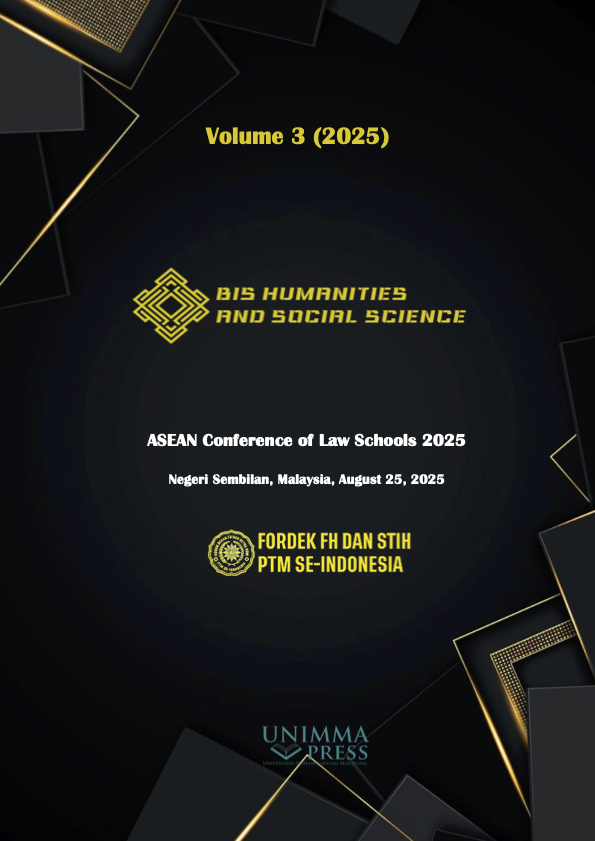From vulnerability to protection: Strengthening ASEAN criminal law frameworks against human trafficking
Keywords:
Human Trafficking, ASEAN, Comparative Criminal Law, Border Governance, Legal HarmonizationAbstract
Human trafficking persists as one of ASEAN’s most pressing and multifaceted transnational crimes, shaped by economic inequalities, porous borders, labor migration, and fragmented enforcement capacities. This paper investigates the uneven prevalence of trafficking across the region by contrasting high-risk frontier areas, such as Temajuk village in Sambas Regency, Indonesia, with developed member states like Singapore and Brunei Darussalam, where cases appear less visible but remain embedded in hidden forms of labor exploitation. The central research question asks: How can ASEAN harmonize its criminal law frameworks to effectively combat human trafficking while addressing diverse socio-economic, political, and legal contexts among its member states? Methodologically, this study employs a qualitative legal approach that integrates doctrinal analysis, comparative legal perspectives, and a contextual case study. The analysis of Decision No. 202/Pid.Sus/2024/PN.Ptk of the Pontianak District Court reveals that, while Indonesia’s Immigration Law (Law No. 6/2011) provides legal certainty, its deterrent effect is limited by the social normalization of undocumented migration through jalur tikus (informal border routes). Comparative findings further show that Cambodia and Myanmar face acute trafficking crises fueled by poverty, instability, and weak governance, whereas Singapore and Brunei employ stronger enforcement but still confront concealed forms of exploitation in regulated labor sectors. This study contributes to ASEAN’s discourse on criminal law by bridging micro-level judicial practice with macro- level regional policy debates. It argues that trafficking cannot be addressed solely through punitive measures but requires a multidimensional framework that simultaneously strengthens law, governance, and socio-economic resilience. The paper proposes three strategic directions: (1) harmonization of trafficking laws and sentencing guidelines, (2) establishment of a regional task force for intelligence-sharing, coordinated investigation, and joint enforcement, and (3) preventive socio-legal measures, including legal literacy, livelihood programs, and safe migration channels. Ultimately, the paper emphasizes that only through coordinated, victim-centered, and justice- oriented regional strategies can ASEAN meaningfully combat human trafficking and uphold its collective commitment to human rights.
References
[1] Law of the Republic of Indonesia Number 6 of 2011 concerning Immigration
[2] Alifia, M. (2025). Analisis yuridis tindak pidana keimigrasian di Desa Temajuk Kabupaten Sambas (Studi Putusan Nomor 202/Pid.Sus/2024/PN.Ptk) (Unpublished undergraduate thesis). Universitas Muhammadiyah Pontianak, Pontianak, Indonesia.
[3] Ahmad, R., & Khairi, A. (2025). Human Security and Governance: Indonesian Illegal Migrant Workers in Malaysia. Journal of Strategic Studies & International Affairs, 4(2), 38–49. https://doi.org/10.17576/sinergi.0402.2024.04
[4] Ariadne, E., Pratamawaty, B. B., & Limilia, P. (2021). Human Trafficking In Indonesia, The Dialectic Of Poverty And Corruption. Sosiohumaniora, 23(3), 356. https://doi.org/10.24198/sosiohumaniora.v23i3.30989
[5] Bal, C. S., & Gerard, K. (2018). ASEAN’s governance of migrant worker rights. Third World Quarterly, 39(4), 799–819. https://doi.org/10.1080/01436597.2017.1387478
[6] Broussard, G. (2017). Building an Effective Criminal Justice Response to Wildlife Trafficking: Experiences from the ASEAN Region. Review of European, Comparative & International Environmental Law, 26(2), 118–127. https://doi.org/10.1111/reel.12203
[7] Bryant, K., & Landman, T. (2020). Combatting Human Trafficking since Palermo: What Do We Know about What Works? Journal of Human Trafficking, 6(2), 119–140. https://doi.org/10.1080/23322705.2020.1690097
[8] Enrile, A. (2024). International Human Trafficking. In A. Enrile, Social Work. Oxford University Press. https://doi.org/10.1093/obo/9780195389678-0331
[9] Ferdous, J., & Khan, N. A. (2024). Re-imagining Migration and Security. In A. K. M. A. Ullah & J. Ferdous (Eds.), Governance, Migration and Security in International Relations (pp. 73–88). Springer Nature Singapore. https://doi.org/10.1007/978-981-99-9424-3_5
[10] Ghazali, F., & Shukor, S. F. A. (2023). Human Trafficking and Forced Labour in Southeast Asia: Legal Framework and a Way Forward. In E. Alaverdov & M. W. Bari (Eds.), Advances in Public Policy and Administration (pp. 37–54). IGI Global. https://doi.org/10.4018/978-1-6684-6334-5.ch003
[11] Hennebry, J. L., Piper, N., Kc, H., & Williams, K. (2022). Bilateral labor agreements as migration governance tools: An analysis from a gender lens. Theoretical Inquiries in Law, 23(2), 184–204. https://doi.org/10.1515/til-2022-0015
[12] Hutama, V., & Sabijanto, V. V. (2023). Meningkatkan Kesadaran Hukum di Kalangan Masyarakat Marginal Melalui Penyuluhan. Multiverse: Open Multidisciplinary Journal, 2(2), 212–218. https://doi.org/10.57251/multiverse.v2i2.1130
[13] Mohammad, N., Islahuddin, I., Setiyani, R. Y., & Sulisworo, D. (2023). Human Trafficking Issue in ASEAN Countries: A Discussion to Overcome. Sang Pencerah: Jurnal Ilmiah Universitas Muhammadiyah Buton, 9(1), 1–9. https://doi.org/10.35326/pencerah.v9i1.3098
[14] Mustika, A. C., & Indrady, A. (2024). Implementation of Immigration Functions in Border Areas Based on Human Security Perspective. Asian Journal of Engineering, Social and Health, 3(5), 1110–1117. https://doi.org/10.46799/ajesh.v3i5.327
[15] OECD. (2022). Society at a Glance: Asia/Pacific 2022. OECD. https://doi.org/10.1787/7ef894e5-en
[16] Qiao-Franco, G. (2023). UN-ASEAN Coordination: Policy Transfer and Regional Cooperation Against Human Trafficking in Southeast Asia. Edward Elgar Publishing. https://doi.org/10.4337/9781800379558
[17] Salamah, L. (2018). Indonesia’s Challenge in Value Implementation ASEAN Convention Against Trafficking in Persons, Women and Children (ACTIP-WC). Proceedings of the International Conference on Contemporary Social and Political Affairs (IcoCSPA 2017). Proceedings of the International Conference on Contemporary Social and Political Affairs (IcoCSPA 2017), Surbaya, Indonesia. https://doi.org/10.2991/icocspa-17.2018.16
[18] Taron, A. (2020). Elisabetta Gentile (Ed), Skilled Labour Mobility and Migration: Challenges and Opportunities for ASEAN Economic Community. Journal of Asian Economic Integration, 2(2), 243–246. https://doi.org/10.1177/2631684620940432
[19] Van Der Leun, J., & Van Schijndel, A. (2016). Emerging from the shadows or pushed into the dark? The relation between the combat against trafficking in human beings and migration control. International Journal of Law, Crime and Justice, 44, 26–42. https://doi.org/10.1016/j.ijlcj.2015.04.001
[20] Yea, S. (2020). Spaces of Deflection and Deportability Beyond Anti-trafficking. In S. Yea, Paved with Good Intentions? (pp. 181–207). Springer Singapore. https://doi.org/10.1007/978-981-13-3239-5_7
[21] Zumbansen, P. (2023). Law’s new cartographies: Spatialization, digital borders and spaces of vulnerability. In A. Parrish & C. Ryngaert (Eds.), Research Handbook on Extraterritoriality in International Law (pp. 92– 116). Edward Elgar Publishing. https://doi.org/10.4337/9781800885592.00013
Downloads
Published
Conference Proceedings Volume
Section
License

This work is licensed under a Creative Commons Attribution-NonCommercial 4.0 International License.

